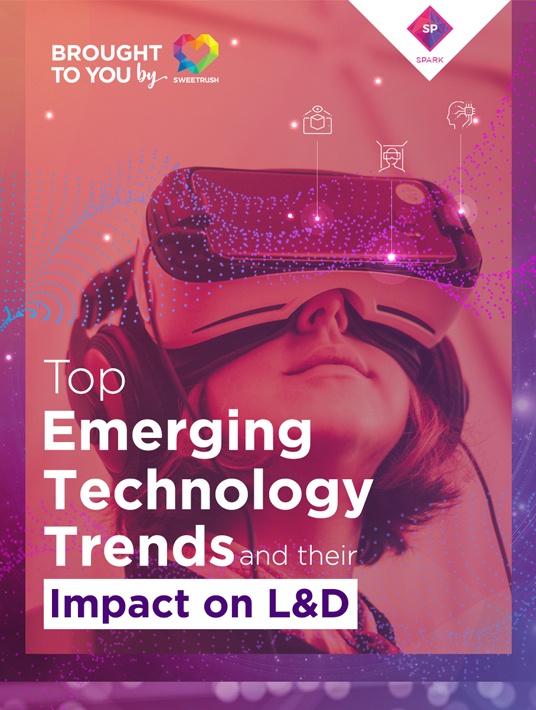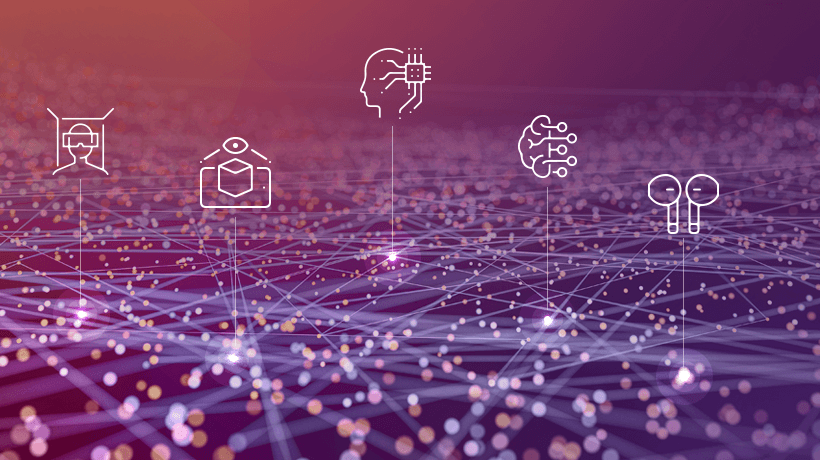Trends Influencing Learning And Development: What's Emerging In The Field?
More than ever before, learners are bombarded with distractions and have easy access to infinite amounts of information. How can Learning and Development (L&D) compete with social media, phone apps and, well, the whole internet? The key, actually, is not to compete but to adapt and take advantage of emerging technology trends influencing Learning and Development, or else the L&D field. "Traditionally, you would have Instructor-Led Training (ILT) or virtual Instructor-Led Training (vILT) and the standard desktop eLearning experience," says Justin Mitchell, a Creative Engineer at SweetRush. "Now, we’re shifting toward a new medium. We have the possibility to combine learning solutions and create something that leverages the shifting landscape of Learning and Development." Let’s take a look at some of the most important, and influential, emerging technology trends and see how they could—if they’re not already—impact the way we design learning and training.

1. Virtual Reality
You've heard the buzz. You've seen people using the headsets. You want to try it, but do you actually know what Virtual Reality (VR) is and how it can best be applied to L&D? VR is one of the most dominant emerging technology trends in L&D to date, in part because the currently available technology has hit a sort of critical mass that finally allows for access at cost-effective prices—and more so all the time. In fact, in 2016, Goldman Sachs predicted that people will spend more on VR than TV by 2025, and the technology will generate between $80 and $110 billion. Nevertheless, what really makes VR stand out as a unique learning tool for the workplace are immersion and presence. In an article by Karl Kapp, researchers Chris Wilson and Alessandro Soranzo define these concepts as follows: "Immersion...describes the level of detail with which a virtual environment can be rendered, while presence describes the user’s psychological response to the said environment." [1]
Combining immersion and presence allows for learners to experience the feeling of being in and experiencing a digitally simulated environment, which in turn leads to higher levels of engagement and retention. VR allows users to experience what it’s like to do something first-hand, something no other medium can do. There are various key uses for VR in learning. "VR transports learners to a different world, and it allows people to do something that might be dangerous, too expensive, or too difficult to repeat in real life," Mitchell explains. Believe the hype. The days when VR was seen as something out of a sci-fi movie are long gone.
2. Augmented Reality
On July 6, 2016, the world went crazy over a mobile game, Pokemon GO, that allowed players to explore their real world and encounter computer-generated Pokemons that they could capture with their phones. That was the first mainstream use of Augmented Reality (AR) that caught our attention. AR overlays a digital image on a real-world environment; the result is a composite view. There are a few key differences between VR and AR, as mentioned by Charles McLellan, editor at ZDNet: "Although VR opens up potentially unlimited virtual worlds, it's a spatially restricted experience as far as the user is concerned. You won't be straying far from a powerful PC when using a cutting-edge immersive VR system... By contrast, AR, almost by definition, requires that user be able to move around relatively freely in the real world." [2] AR can enhance traditional learning by offering a 3D view of objects, which allows for better comprehension. Imagine med students looking at a 3D model of a heart, with the chance to open it up and see what the real thing would look like. AR is not just about making the learning process more interesting and fun; it’s fundamentally about increasing comprehension through the visualization of objects that would be difficult to replicate in real life. An article by the Harvard Business Review [3] revealed that AR can "boost workers’ productivity on an array of tasks the first time it’s used, even without prior training." The article focuses on the use of AR smart glasses in manufacturing and reports that by overlaying job aids like videos, graphics or text onto objects, AR glasses can, for instance, allow workers to view repair instructions while they are repairing an object. "AR elevates existing information. It gives us an opportunity to take something that might be stale and dry, and bring it to life," adds Mitchell. "It’s the difference between looking at a statue in a textbook and looking at it right in front of you, appreciating all the details, and understanding what it would look like in real life."
3. Artificial Intelligence
Although the concept of Artificial Intelligence (AI) may sound a bit scary, the truth is AI is already around us. Amazon’s Alexa, Apple's Siri, and even the Google search engine rely on AI by learning from users. "AI is a great source for just-in-time information," says Mary Gannon, Ph.D., Senior Learning Strategist at SweetRush. "A big part of L&D is not just formal learning. It is also what happens on the job. That's when AI comes in through internet searches and other performance support systems that can help people learn what they need just in time." Mitchell adds that "one of the things lacking in L&D is smarter learning paths. With AI, we can learn from the user; we can understand what they're good at, what they struggle with. This allows us to show them only information that is relevant to them, personalized."
4. Big Data
Big data is a concept used to describe large volumes of data that can be analyzed in order to mine insights that lead to better decisions. In terms of learning, an article by Christopher Pappas says that "Big Data (...) is the data that is created by learners while they are taking an eLearning course or training module." Its main appeal comes from what this information can be used for. Custom tracking systems using Experience API (xAPI) can help collect data about learning experiences and build more flexible solutions. Gannon says that Big Data can be used to understand how the learner is acquiring information and at what pace; this allows Instructional Designers to create more personalized learning paths. Andrew Kubay, a Lead Engineer at SweetRush, agrees: "Data is a very, very powerful tool for analysis that can help improve eLearning in any company."
"Instead of simply devising training, rolling it out and hoping it works—that is, a first-best-guess at what a learner needs—use the training to gather data on how people think, believe, and act, for example in simulated situations," says John Cleave, PhD, an eLearning Technologist at SweetRush. "Then use that data to drive further training decisions."
5. Podcasts
Surprised? We understand. Traditionally, podcasts haven’t been considered useful in learning: listening to someone talk for an hour is quite similar to a lecture, which isn’t usually the most engaging way to learn. However, what’s turning the tide is that, as Gannon puts it, "podcasts are really becoming more prevalent in the world in general, and the art and knowledge of how to create an engaging podcast are growing." It’s true. According to Statista [4], podcast consumption in the US has grown steadily up to 26% over the past 10 years. As podcasts become more popular, Gannon believes they will make their way to the L&D field. Podcasts do not need to be particularly long; done well, they can be an engaging experience. Podcasts are not exactly an emerging technology, but rather an emerging use of a technology that’s been around for a while. "I think we’re going to see more of it, maybe not as part of L&D because of legal issues—for example, should learners get paid while they listen to a podcast? But I already see it being used by learners interested in their own career growth," says Gannon. Furthermore, she says, "There are advantages for certain audiences. They can learn when they’re driving—or doing the dishes, for that matter."
***
These are exciting days for the L&D field. The better we understand the emerging technology trends popping up around us, the better learning and training experiences we’ll be able to develop. The future’s bright for learners. Watch this space for further—and deeper—insights into emerging technology trends for L&D from the SPARK team at SweetRush.
Download the eBook Top Emerging Technology Trends And Their Impact On L&D to see how the evolution of virtual reality and augmented reality can open up new methods of working for L&D professionals. Learn why they are important vehicles in teaching and influencing behavioral change and how they can help you accomplish your business objectives.
If you want to learn further about the unique features you need to implement Virtual Reality in your organization, check out the webinar Virtual Reality: Real-World Hilton/SweetRush Project Case Studies. It is brought to you by SweetRush and explains everything you need to know to run an exceptional VR learning program.
References:
- Four Essentials for Effective Learning Using Virtual Reality
- AR and VR: The future of work and play?
- Augmented Reality Is Already Improving Worker Performance
- Share of U.S. population that have listened to an audio podcast in the last month from 2008 to 2018










